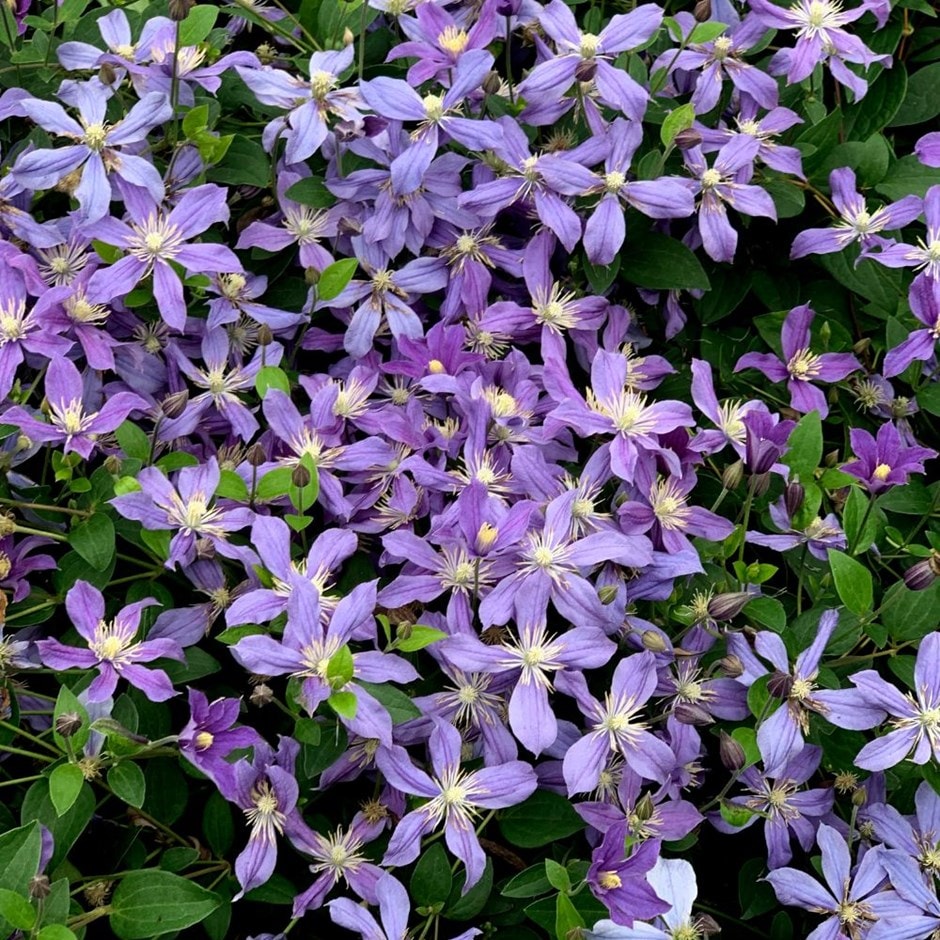
Masses of small, deep mauve-blue flowers that fade to light blue are produced from July to September. This semi-herbaceous clematis is a non-clinging variety so is perfect for scrambling through shrubs in the border. It's a small clematis and is ideal for growing in pots on the patio where it can grow up small supports, such as an obelisk.
How to care for Clematis Arabella:
To avoid dry conditions, and to ensure good soil contact around the rootball, we advise planting climbers at least 30cm (12in), and preferably 45-60cm (18-24in) away from the base of a wall or fence. An even larger distance should be maintained when planting climbers beside an existing tree or shrub.
In early spring cut back the previous year's stems to a pair of strong buds about 15-20cm (6-8in) above ground level and apply a slow-release balanced fertiliser and a mulch of well-rotted garden compost around the plant, avoiding the immediate crown.
Flowering period:
- Jan
- Feb
- Mar
- Apr
- May
- Jun
- Jul
- Aug
- Sep
- Oct
- Nov
- Dec
Eventual height:
Eventual spread:
Position:
Full sun / light shade
Rate of growth:
Slow growing
Soil:
Moderately fertile, moist, well-drained soil
Hardiness:
Fully hardy
-
This climber is deciduous so it will lose all its leaves in autumn, then fresh new foliage appears again each spring.
-
Humans: Skin irritant; Pets: Harmful if eaten
Product options
Add to basket
Delivery options (pick your preferred option at checkout)

Masses of small, deep mauve-blue flowers that fade to light blue are produced from July to September. This semi-herbaceous clematis is a non-clinging variety so is perfect for scrambling through shrubs in the border. It's a small clematis and is ideal for growing in pots on the patio where it can grow up small supports, such as an obelisk.
How to care for Clematis Arabella:
To avoid dry conditions, and to ensure good soil contact around the rootball, we advise planting climbers at least 30cm (12in), and preferably 45-60cm (18-24in) away from the base of a wall or fence. An even larger distance should be maintained when planting climbers beside an existing tree or shrub.
In early spring cut back the previous year's stems to a pair of strong buds about 15-20cm (6-8in) above ground level and apply a slow-release balanced fertiliser and a mulch of well-rotted garden compost around the plant, avoiding the immediate crown.
Flowering period:
- Jan
- Feb
- Mar
- Apr
- May
- Jun
- Jul
- Aug
- Sep
- Oct
- Nov
- Dec
Eventual height:
Eventual spread:
Position:
Full sun / light shade
Rate of growth:
Slow growing
Soil:
Moderately fertile, moist, well-drained soil
Hardiness:
Fully hardy
-
This climber is deciduous so it will lose all its leaves in autumn, then fresh new foliage appears again each spring.
-
Humans: Skin irritant; Pets: Harmful if eaten
